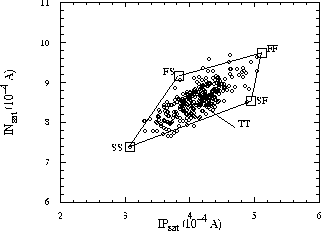 corner the statistical input variables
must be determined such as the current ratio satisfies the equation:
corner the statistical input variables
must be determined such as the current ratio satisfies the equation:





Once the worst case conditions of the selected performance objective
have been calculated, the inverse problem that consists of determining
the input variables values that will produce these conditions needs to
be solved. As an example, for the  corner the statistical input variables
must be determined such as the current ratio satisfies the equation:
corner the statistical input variables
must be determined such as the current ratio satisfies the equation:
This is an under-determined problem that could have an infinite number of solutions. In [24], a method to resolve this uncertainty is proposed. It is suggested that the most probable input vector with minimum probability distance be selected. This corresponds to a maximum value of the multinormal jpdf of the input variables which is reached when the argument of the exponential in (2.63) is at its minimum:

where X is the vector of statistical variables with mean  and
covariance matrix C:
and
covariance matrix C:

The function  denotes the empirical relationship represented in
Equation 6.7. The above problem can be solved by nonlinear programming
to determine the values of the statistical input variables at the corners.
For example, Table 6.3 lists the input vectors for the
denotes the empirical relationship represented in
Equation 6.7. The above problem can be solved by nonlinear programming
to determine the values of the statistical input variables at the corners.
For example, Table 6.3 lists the input vectors for the  and
and  corners as determined by the maximum probability method.
corners as determined by the maximum probability method.

Figure 6.2:
Simulated  and
and  distributions for a
distributions for a  m CMOS
technology.
m CMOS
technology.

Table 6.3: Values of the statistical input variables at the FS and SF corners.
Using the above procedure, the values of the principal statistical
variables that will result in the performance function limits can be
determined. A complete specification of the design process variation space
becomes possible. This is illustrated for  and
and  in Fig. 6.2 where the center and corners are superimposed on the
simulated distribution.
in Fig. 6.2 where the center and corners are superimposed on the
simulated distribution.
It is important to note that an identical approach can be applied to other circuit level performance functions in case the use of the P- and N-channel saturation currents is not an adequate objective function.




